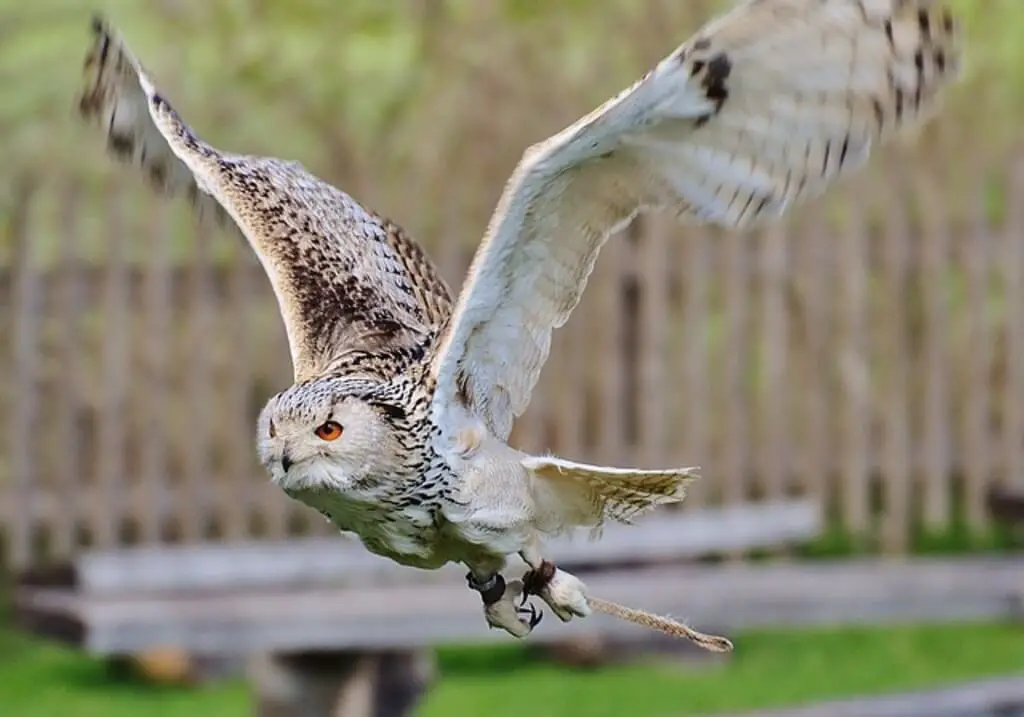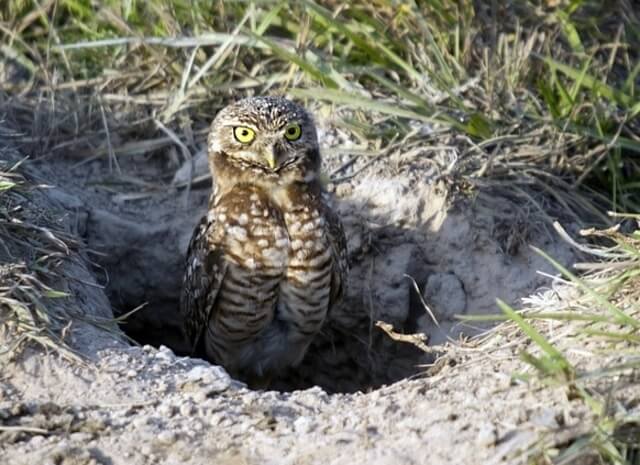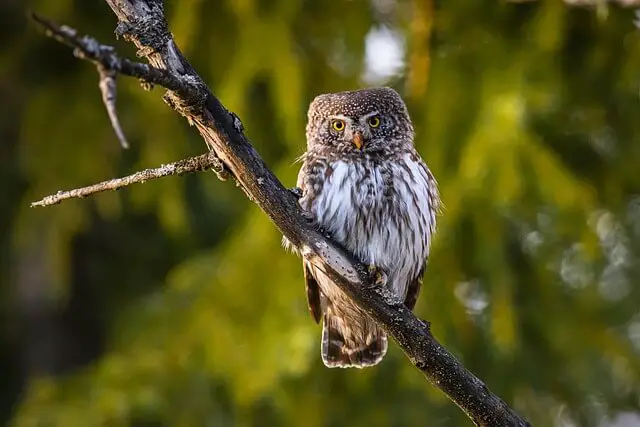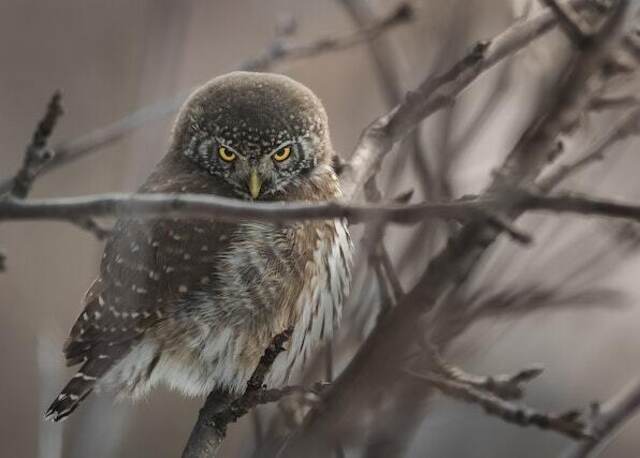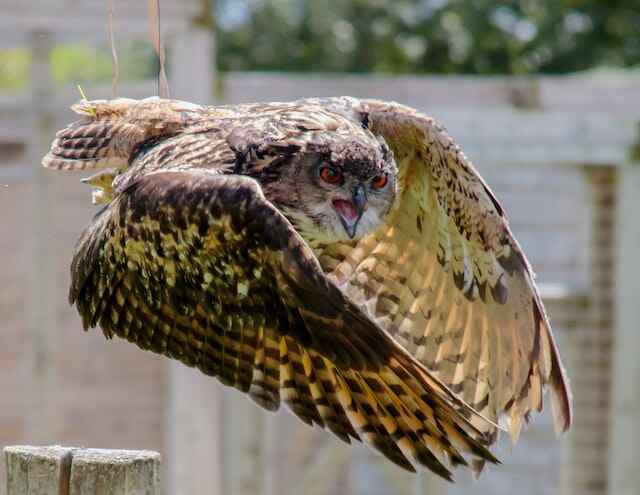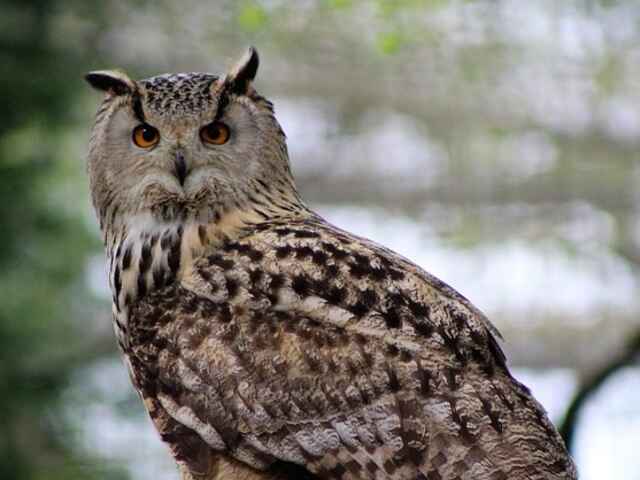Owls have captivated humans for centuries with their mysterious presence and nocturnal habits. Known for their silent flight and haunting calls, these remarkable birds offer a treasure trove of fascinating facts. From their unique anatomy to their diverse habitats and intriguing behaviors, there’s much to discover about these enigmatic nocturnal hunters. Whether you’re a seasoned birdwatcher or just curious, prepare to be amazed by the wonders of owls.
Table of Contents
- 1 Interesting Facts About Owls
- 1.1 The Mystery Behind Owl Hoots
- 1.2 Where Do Owls Nest?
- 1.3 Owls Have a Rapid Heart Rate: 131-445 Beats Per Minute
- 1.4 Owls Can Turn Their Heads 270 Degrees
- 1.5 Over 200 Species of Owls Roam the Earth
- 1.6 Owls Have 14 Vertebrae—Twice as Many as Humans
- 1.7 Owls’ Unique Bone Structure: Supporting Stealth and Agility
- 1.8 The Northern Pygmy Owl: The Cutest Owl Species
- 1.9 The Elf Owl: The Smallest Owl Species on Earth
- 1.10 Owls Have Exceptional Night Vision
- 1.11 Owls’ Asymmetrical Ears Aid in Locating Prey
- 1.12 Owls Have Unmatched Hearing Ability
- 1.13 Owls Have Three Eyelids
- 1.14 Owls Live on Every Continent Except Antarctica
- 1.15 Blakiston’s Fish Owl: The Largest Owl Species
- 1.16 Owls Have Hooked Beaks for Ripping Flesh
- 1.17 Owls Are Carnivorous and Have a Varied Diet
- 1.18 Owls Have Large, Stationary Eyes
- 1.19 Owls Are Mostly Nocturnal
- 1.20 Owls Have Silent Flight Thanks to Special Feathers
- 1.21 Owls Have Been Around for Millions of Years
- 1.22 Owls Are Solitary Creatures
- 1.23 The Symbolism of Owls in Different Cultures
- 1.24 Owls Can Live a Long Time
- 1.25 Owls Occasionally Attack Humans
- 1.26 Owls Are Exceptional Hunters
- 1.27 Owls as Natural Pest Control
- 1.28 Owls Have Been Trained for Hunting
- 1.29 Owls Communicate in Unique Ways
- 1.30 Owls in Literature and Art
- 1.31 Owls Exhibit Unusual Behaviors
- 1.32 Owls in Scientific Research
- 1.33 Owls Often Form Lifelong Partnerships
- 1.34 Owls Have Been Used in Falconry
- 1.35 Owls Face Threats from Habitat Loss
- 1.36 Owls in Myths and Legends
- 1.37 Owls in Traditional Medicine
- 1.38 Owls in Popular Media
- 1.39 Owls Have Been Used as Symbols in Advertising
- 1.40 Owls Continue to Captivate and Inspire
- 2 Conclusion
- 3 Author
Interesting Facts About Owls
The Mystery Behind Owl Hoots
The distinctive sound an owl makes is called “hooting.” This sound is produced as air moves through their lungs while they exhale. Interestingly, owl hoots can carry for miles, with some calls echoing off hillsides and buildings, amplifying their reach. These vocalizations are essential for communication, especially in dense forests or open fields where hearing long distances can help owls locate mates or mark their territory.
Where Do Owls Nest?
Owls are incredibly adaptable when it comes to nesting. Many species find shelter in tree trunks or make nests directly on the ground. One notable example is the burrowing owl, which spends much of its life underground. This species digs its nest in abandoned burrows or hollowed-out tree trunks to keep warm and hidden from predators. Similarly, the long-eared owl also nests in tree cavities or dug-out holes, providing a safe space for raising its young. These nesting behaviors show just how resourceful owls are in different environments.
Owls Have a Rapid Heart Rate: 131-445 Beats Per Minute
Owls have an impressive heart rate that can range from 131 to 445 beats per minute. To put that in perspective, the average human heart rate is between 60 and 100 beats per minute. This rapid heart rate is crucial for their survival, as owls constantly regulate their body temperature. By adjusting their heart rate and feather position, they maintain the necessary warmth needed for nighttime hunting in colder environments.
Owls Can Turn Their Heads 270 Degrees
One of the most fascinating features of owls is their ability to rotate their heads up to 270 degrees. This unique adaptation is made possible by their flexible necks, which contain 14 vertebrae—twice as many as humans. While other birds can only manage about 180 degrees of rotation, owls can turn their heads far enough to look in almost any direction without moving their bodies. This allows them to spot prey from almost any angle.
Over 200 Species of Owls Roam the Earth
Did you know that there are about 200 species of owls worldwide? These amazing birds can be found on every continent except Antarctica. While only 19 species are native to North America, they represent one-third of the owl species across the globe, showcasing the diversity and adaptability of these nocturnal creatures in various habitats.
Owls Have 14 Vertebrae—Twice as Many as Humans
Owls’ impressive ability to turn their heads comes from their 14 neck vertebrae, double the number humans have. This extra flexibility is vital for hunting, allowing them to rotate their heads to detect prey without moving their bodies, ensuring stealth and precision in their movements.
Owls’ Unique Bone Structure: Supporting Stealth and Agility
Owls have a specialized skeletal structure that is perfectly adapted for flight. The weight of their bones makes up about 7-9% of their total body weight, contributing to their agility and stealth. Their bones are lightweight yet strong, providing the necessary support for their silent flight and incredible maneuverability. The bones in their wings, which make up just a small percentage of their total body weight, play a key role in their flight capabilities, allowing them to navigate through the night with precision.
The Northern Pygmy Owl: The Cutest Owl Species
When it comes to charm, the Northern Pygmy Owl takes the cake. With its heart-shaped face, this tiny owl is often considered the cutest of the bunch. Native to Canada and Alaska, it thrives in forested areas near rivers or lakes, where it hunts small prey. Despite its diminutive size, this little owl packs a lot of character!
The Elf Owl: The Smallest Owl Species on Earth
The Elf Owl holds the title of the smallest owl species in the world. Standing at just 5–6 inches tall with a wingspan of 10–11 inches, this tiny owl weighs only 1.5 ounces (42.5 grams). Despite its small size, the Elf Owl is a skilled predator and thrives in both North and South America. It can be found in plantations, orchards, parks, and gardens, where it hunts insects like crickets, moths, and beetles.
Owls Have Exceptional Night Vision
One of the most impressive adaptations of owls is their ability to see in low light. With their large, forward-facing eyes and binocular vision, they have exceptional night vision that helps them hunt effectively in the dark. This makes them well-equipped for nocturnal hunting, allowing them to track prey with precision in the night sky.
Owls’ Asymmetrical Ears Aid in Locating Prey
Owls are masters of hearing, using their asymmetrical ears to detect sounds from a wider range of angles. One ear is larger than the other, which helps them pinpoint the exact location of their prey. This unique feature is especially beneficial for nocturnal hunters that rely on sound to navigate and hunt in the darkness.
Owls Have Unmatched Hearing Ability
Owls are known for having exceptional hearing, which allows them to detect even the faintest sounds, such as a mouse moving on the ground or an insect rustling in the leaves. While owls have highly sensitive hearing, the distance at which they can detect sounds depends on the environment, but they are typically able to hear prey from much closer distances. Their incredible sensitivity is due to their asymmetrical ears and specialized ear openings, which improve their ability to locate sounds in multiple directions.
In contrast, humans have symmetrical ears with one opening per ear, limiting our ability to detect sounds coming from behind us. Owls, with their unique ear structure, are able to precisely pinpoint the direction of sounds, making them highly effective hunters during the night.
Owls Have Three Eyelids
Owls are unique in that they have three eyelids. These include the nictitating membrane, a thin layer that protects the eye from dust and debris; the cornea, which is responsible for about two-thirds of their vision; and the “haw,” a third eyelid that helps protect their eyes while hunting in tight spaces like tree branches or deep crevices. This adaptation keeps their eyes safe during close-quarters hunting.
Owls Live on Every Continent Except Antarctica
Owls are found on every continent, except Antarctica. They are adaptable birds and thrive in various environments, from deserts to rainforests. However, they cannot live in Antarctica due to the lack of trees, which they rely on for roosting. Their ability to inhabit diverse habitats speaks to their resilience and wide-ranging survival skills.
Blakiston’s Fish Owl: The Largest Owl Species
The largest owl in the world is Blakiston’s Fish Owl, which can grow up to 28 inches in length and weigh about 7.5 pounds, with an impressive 6-foot wingspan. These owls live near large bodies of water, such as lakes and rivers, and have a diet that includes fish, crustaceans, amphibians, and small mammals. Their large size and specialized diet make them one of the most remarkable owl species.
Owls Have Hooked Beaks for Ripping Flesh
While owls don’t have teeth, they have sharp, hooked beaks designed to rip and tear flesh from their prey. These beaks are incredibly strong, allowing owls to efficiently break down their meals. The hook-like shape of the beak helps them cut through meat and feathers, making it easier to consume their prey.
Owls Are Carnivorous and Have a Varied Diet
Owls are strict carnivores with a varied diet that includes rodents, birds, insects, fish, and even other owls. For example, the snowy owl can consume up to 1,600 lemmings per year. They typically swallow their prey whole and later regurgitate pellets containing undigested bones, fur, and feathers.
Owls Have Large, Stationary Eyes
Owls possess some of the largest eyes of any bird, but their eyes are fixed in their sockets. This means they cannot move their eyes to look around, so they must turn their entire head. Their eyes are specially adapted for low-light conditions, with a high concentration of light-sensitive cells called rods, which help them see well in the dark.
Owls Are Mostly Nocturnal
Owls are primarily nocturnal, meaning they are most active at night and sleep during the day. However, some species, like the snowy owl, are active during daylight hours as well. Their adaptations, such as excellent night vision, make them well-suited for hunting in low-light conditions.
Owls Have Silent Flight Thanks to Special Feathers
One of the owl’s most remarkable features is its ability to fly silently. Their feathers have unique structures, including a soft fringe, which helps muffle the sound of air moving over their wings. This stealthy flight ability allows them to approach their prey without being heard, making them some of the quietest fliers in the animal kingdom.
Owls Have Been Around for Millions of Years
According to fossil evidence, owls have existed for at least 60 million years. Over this long period, they have developed a variety of specialized adaptations—such as silent flight, superior hearing, and sharp talons—that have helped them become successful nocturnal predators.
Owls Are Solitary Creatures
Owls are generally solitary animals. They typically come together only for mating or raising their young. However, some species, such as the snowy owl, may form large groups during the winter to hunt and roost.
The Symbolism of Owls in Different Cultures
Throughout history, owls have been associated with wisdom, mystery, and even death. In Ancient Greece, Athena, the goddess of wisdom, was often depicted with an owl, symbolizing knowledge and intelligence. In contrast, many Native American cultures viewed owls as omens of death or messengers from the spirit world.
Owls Can Live a Long Time
While many owls face challenges in their first year due to predation, disease, or food scarcity, some species can live up to 25 years in the wild. Their longevity depends on factors such as habitat, diet, and threats from predators or human activity.
Owls Occasionally Attack Humans
Though rare, owls have been known to attack people, usually when defending their nests. These incidents are most common during the breeding season when owls become highly territorial and protective of their young.
Owls Are Exceptional Hunters
Equipped with razor-sharp talons and powerful hooked beaks, owls are efficient predators. Some species, like the great horned owl, can take down prey larger than themselves, including rabbits and other birds of prey.
Owls as Natural Pest Control
Farmers and gardeners have long relied on owls to help manage rodent populations. As natural predators of mice and rats, owls provide an eco-friendly alternative to chemical pesticides, helping to maintain a balanced ecosystem.
Owls Have Been Trained for Hunting
In some cultures, owls have been trained to hunt small game such as rabbits and squirrels. While falconry is more commonly associated with hawks and falcons, certain owl species have also been used in this practice, a tradition that continues in some regions today.
Owls Communicate in Unique Ways
Unlike songbirds, owls use a diverse range of hoots, screeches, whistles, and other calls to communicate. Each species has its own distinct vocalizations, which can help identify them in the wild. Some owls even use body language, such as head bobbing or wing movements, to convey messages.
Owls in Literature and Art
Owls have been featured in folklore, literature, and art for centuries. From Hedwig in Harry Potter to the wise old owl in Winnie-the-Pooh, they are often depicted as symbols of wisdom and mystery. Their presence in ancient cave paintings, medieval manuscripts, and modern sculptures highlights their lasting cultural significance.
Owls Exhibit Unusual Behaviors
Some owl species engage in unexpected behaviors, such as sunbathing, where they spread their wings and soak up the sunlight. Others practice “anting,” rubbing ants on their feathers to ward off parasites. These behaviors showcase the fascinating and sometimes quirky nature of owls.
Owls in Scientific Research
Scientists study owls to better understand their remarkable adaptations. Their silent flight has inspired advancements in aerodynamics, while their exceptional hearing has contributed to research on auditory processing. Studying owls has provided valuable insights into biomechanics, neurology, and even robotics.
Owls Often Form Lifelong Partnerships
Some owl species, such as barn owls, form lifelong bonds with a mate, staying together year-round. These devoted pairs roost side by side during the day and often communicate through soft calls. During breeding season, they work together to raise their young, with one parent hunting while the other guards the nest. Some species even perform courtship displays throughout their lives to reinforce their bond.
Owls Have Been Used in Falconry
Although falconry is typically associated with hawks and falcons, some owl species, like the Eurasian eagle owl, have also been trained to hunt. Their keen eyesight, silent flight, and sharp talons make them formidable hunters. However, due to their independent nature and nocturnal habits, training owls for falconry is more challenging compared to other birds of prey. While less common today, historical records show owls being used in hunting traditions across different cultures.
Owls Face Threats from Habitat Loss
Many owl species are experiencing population declines due to habitat destruction, deforestation, and climate change. As forests are cleared for agriculture and urban expansion, owls lose vital nesting and hunting grounds. Pollution and pesticide use also reduce prey availability, further threatening their survival. Conservation efforts, such as reforestation projects and protected wildlife areas, are crucial to ensuring these incredible birds thrive in their natural habitats for future generations.
Owls in Myths and Legends
Throughout history, owls have been both revered and feared in various cultures. In Greek mythology, the owl was a symbol of wisdom, representing Athena, the goddess of knowledge. However, in some Native American traditions and African folklore, owls were considered omens of death or misfortune. Some cultures believed hearing an owl’s hoot at night was a warning of impending danger, while others saw owls as guides between worlds.
Owls in Traditional Medicine
In certain cultures, owls have been used in traditional medicine for centuries, with different parts of the bird believed to hold healing properties. Owl eggs were once thought to improve eyesight, while owl feathers were used in remedies for asthma and respiratory issues. Some folk traditions even held that owl bones or organs could provide protection against evil spirits. While these beliefs persist in some regions, modern conservationists discourage harming owls for superstitions.
Owls in Popular Media
Owls have long fascinated people and frequently appear in literature, movies, and television. From the wise and mysterious Hedwig in Harry Potter to the philosophical owl in Winnie-the-Pooh, these birds have been portrayed as intelligent and magical creatures. Films like Legend of the Guardians: The Owls of Ga’Hoole showcase their beauty and stealth, while documentaries highlight their real-world hunting skills. Their presence in pop culture continues to captivate audiences of all ages.
Owls Have Been Used as Symbols in Advertising
Owls have been featured in advertising for a wide range of products, from coffee and beer to educational tools and luxury brands. Their strong association with wisdom, intelligence, and mystery makes them a compelling marketing symbol. Companies often use owl imagery to convey trustworthiness, knowledge, or even nighttime activity, such as in advertisements for late-night study aids or energy drinks. The iconic Woodsy Owl from environmental campaigns is another example of how owls have been effectively used in branding.
Owls Continue to Captivate and Inspire
Owls are some of the most fascinating creatures in the natural world, capturing the imaginations of birdwatchers, scientists, and storytellers alike. From their silent flight and extraordinary vision to their ability to rotate their heads nearly 270 degrees, these birds possess unique adaptations that set them apart. Their presence in myths, legends, and modern culture further adds to their intrigue. Whether glimpsed in the wild or admired from afar, owls continue to inspire awe and admiration across generations.
Conclusion
In conclusion, owls are fascinating creatures with many unique and interesting qualities. From their silent flight to their exceptional eyesight, there is much to learn and appreciate about these majestic birds. We hope these fun facts have given you a new appreciation for owls and their place in the natural world. Keep exploring and learning about these amazing creatures!
Handpicked Related Post:

